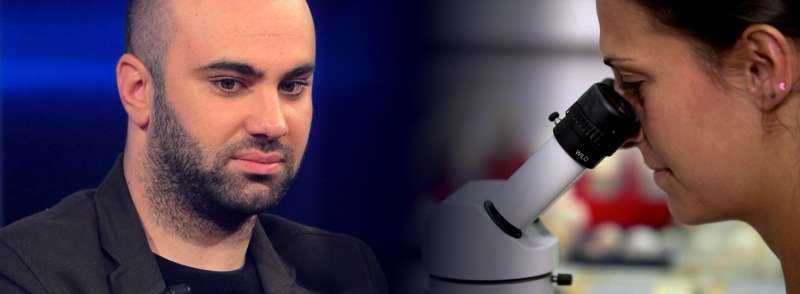The researchers dedicated, with admiration and affection, their discovery to Bjorn Formosa, a Malta-born motor neuron disease sufferer, campaigner and founder of ALS Malta. Credit: University of Malta
A new study by a team of scientists from the University of Malta and the Institut de Génétique Moléculaire de Montpellier (CNRS/Université de Montpellier) could help develop treatment strategies for a crippling disorder that was the focus of the Ice Bucket Challenge, the world's largest global social media phenomenon. The findings uncover a mechanism that explains how motor neuron disease develops.
Motor neuron diseases affect the motor neurons or cells in the brain and spinal cord that control the muscles. They rob patients of their ability to walk, eat, talk or breathe. Amyotrophic lateral sclerosis (ALS) affects adults while spinal muscular atrophy (SMA) mostly strikes young children. SMA patients inherit a flaw in the Survival Motor Neuron (SMN) gene that decimates the levels of the SMN protein, causing motor neurons and associated muscles to die.
The SMN protein has been implicated in the assembly of the splicing machinery that cuts and pastes the cell's genetic instructions together. Whether this basic biological function is disrupted in SMA was unclear. Now, the research team discovered that the disruption of the cellular proteins pICln and Tgs1, two chief players that help assemble the splicing machinery, causes the fruit flies' neuromuscular system to collapse in a similar manner to patients with SMA.
The breakthrough discovery was reported in the journal Neurobiology of Disease and implies that a failure to correctly process the genetic blueprint that produces correctly working proteins is likely to blame for the neuromuscular deficits in young patients with motor neuron disease.
"Therapies have been difficult to develop because of the lack of clarity on how a shortage of the SMN protein leads to motor neuron death and muscle weakness in patients," said the study's lead author Ruben J. Cauchi, PhD, a faculty member of the University of Malta's School of Medicine and Surgery.
The splicing machinery is essential for the health of all cells. However, in humans and flies, when there is a shortfall in the SMN protein, only motor neurons and muscle cells become sick, while the rest mostly survive. "Our study solves this mystery by showing that the motor neurons and muscles are highly sensitive to disturbances in the assembly of the splicing machine, consequently leading to them being selectively injured," remarked Cauchi.
Because of similar symptoms, the hunch that ALS and SMA are related was proven correct with many studies showing the same cellular mechanisms underpin both disorders. The splicing machinery in severely hit in most ALS patients.
"A shared mechanism translates into a common treatment," remarked Rémy Bordonne, PhD, CNRS principal investigator and study co-author. Right now the research team is teasing out further details of the disease mechanism since this will steer researchers on a path towards much-needed treatment for motor neuron diseases.
More information: Rebecca M. Borg et al, Disruption of snRNP biogenesis factors Tgs1 and pICln induces phenotypes that mirror aspects of SMN-Gemins complex perturbation in Drosophila, providing new insights into spinal muscular atrophy, Neurobiology of Disease (2016). DOI: 10.1016/j.nbd.2016.06.015
Journal information: Neurobiology of Disease
Provided by University of Malta





















